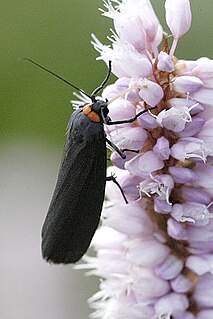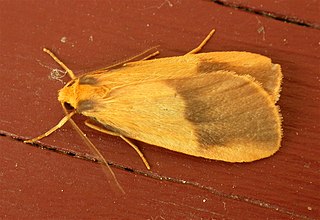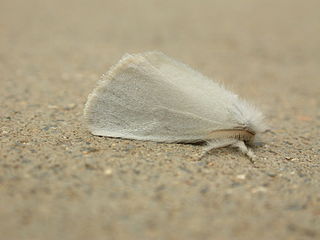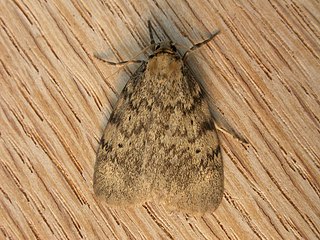
Orgyia is a genus of tussock moths of the family Erebidae. The genus was described by Ochsenheimer in 1810. The species are cosmopolitan, except for the Neotropical realm.

Anestia is a genus of moth in the subfamily Arctiinae.

Atolmis rubricollis, the red-necked footman, is a small moth of the family Erebidae. It is found in the summer in forested regions of Europe and Northern Asia. This moth was first described by Carl Linnaeus in his 1758 10th edition of Systema Naturae.

Miltochrista miniata, the rosy footman, is a moth of the family Erebidae. The species was first described by Johann Reinhold Forster in 1771. It is found in the temperate parts of the Palearctic realm – Europe, Asia Minor, Caucasus, northern Kazakhstan, southern Siberia, Amur, Primorye, Sakhalin, southern Kuriles, Heilongjiang, Liaoning, Hebei, Inner Mongolia, Shanxi, Sichuan, Korea and Japan, but may be replaced by Miltochrista rosaria in the eastern Palearctic.

Katha depressa, the buff footman, is a moth of the family Erebidae found in Asia and Europe. It was first described by Eugenius Johann Christoph Esper in 1787.

Palaeosia is a monotypic moth genus in the family Erebidae erected by George Hampson in 1900. Its only species, Palaeosia bicosta, the two-ribbed arctiid or two-ribbed footman, was first described by Francis Walker in 1854. It is found in south-eastern Australia.
Parelictis is a monotypic moth genus in the subfamily Arctiinae. Its only species, Parelictis saleuta, the mottled footman, has been recorded from the Australian states of New South Wales and Victoria. Both the genus and species were first described by Edward Meyrick in 1886.

Thallarcha sparsana, the fair footman, is a moth of the subfamily Arctiinae. The species was first described by Francis Walker in 1863. It is found in the Australian states of Victoria, New South Wales and Queensland.

Threnosia heminephes, the halved footman, is a moth of the subfamily Arctiinae first described by Edward Meyrick in 1886. It is found in Australia, where it has been recorded from the Australian Capital Territory, New South Wales and Victoria.

Acyphas semiochrea, the omnivorous tussock moth, is a moth of the subfamily Lymantriinae first described by Gottlieb August Wilhelm Herrich-Schäffer in 1855. It is found along most of the coast of Australia, including: New South Wales, Queensland, South Australia, Tasmania, Victoria and Western Australia.
Mestolobes semiochrea is a moth of the family Crambidae described by Arthur Gardiner Butler in 1882. It is endemic to the Hawaiian island of Oahu.

Hectobrocha adoxa, the unadorned footman, is a species of moth of the subfamily Arctiinae first described by Edward Meyrick in 1886. It is known from the Australian states of New South Wales and Victoria.

Anestia ombrophanes, the clouded footman, is a moth of the subfamily Arctiinae. The species was first described by Edward Meyrick in 1886. It is known from the Australian Capital Territory, New South Wales, Queensland, Western Australia, Victoria and South Australia.
Hesychopa chionora, the white footman, is a moth of the subfamily Arctiinae. It was described by Edward Meyrick in 1886. It is found in the Australian states of Victoria, Queensland and New South Wales.
Damias procrena, the procrena footman, is a moth of the family Erebidae. The species was first described by Edward Meyrick in 1886. It is found in the Australian states of Victoria and Tasmania.
Hectobrocha pentacyma, the five-banded footman, is a moth of the subfamily Arctiinae. It was described by Edward Meyrick in 1886. It is found in the Australian states of Queensland, New South Wales and Victoria.
Scaptesyle dichotoma, the reticulated footman, is a moth in the subfamily Arctiinae. It was described by Edward Meyrick in 1886. It is found in Australia, where it has been recorded from Queensland, New South Wales, and Victoria.
Thallarcha chrysochoa, the golden footman, is a moth in the subfamily Arctiinae. It was described by Edward Meyrick in 1886. It is found in Australia, where it has been recorded from the Australian Capital Territory, New South Wales and Victoria.
Thallarcha phalarota, the adorned footman, is a moth in the subfamily Arctiinae. It was described by Edward Meyrick in 1886. It is found in Australia, where it has been recorded from the Australian Capital Territory, New South Wales, Queensland and Victoria.
Scoliacma pactolias is a moth in the family Erebidae. It was described by Edward Meyrick in 1886. It is found in Australia, where it has been recorded from the Australian Capital Territory, New South Wales, Queensland, South Australia, Tasmania and Victoria.











